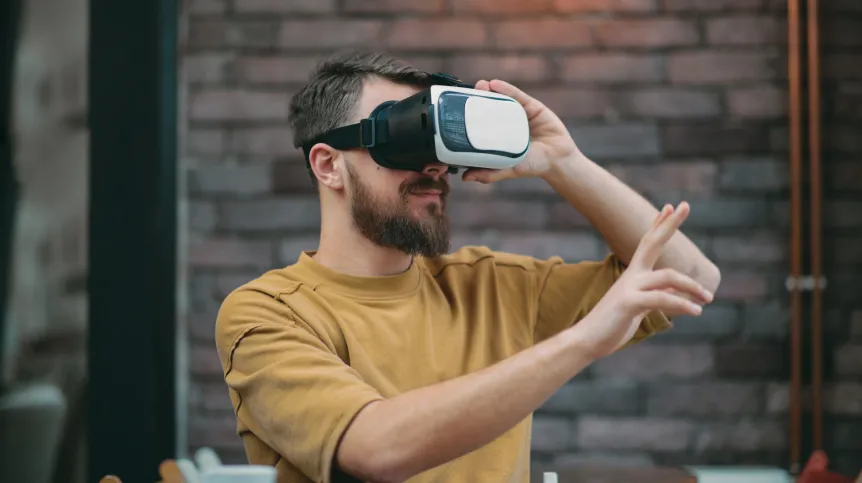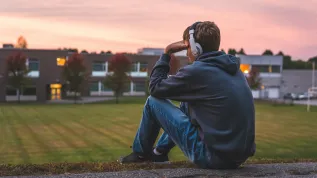
Fear of spiders, open spaces, heights? Research shows that virtual reality can actually be an effective tool to treat with phobias, argue researchers from SWPS University, Gdańsk University of Technology and Jagiellonian University.
Virtual reality (VR) increasingly permeates our daily lives. It enhances the attractiveness of computer games, events, museum exhibitions. It is also used for educational and training purposes, for example, to improve doctors' social skills, or to visualise complex chemical compounds.
Virtual reality techniques have also been used in therapy. Research shows that smokers who participate in sessions in a virtual bar, where they are exposed to known smoking triggers, significantly cut down on the number of cigarettes they smoke daily . Similarly, gambling addicts, subjected to therapy in a virtual casino, report a significant decrease in their urge to gamble, we read in a press release from SWPS University.
Phobias are a sub-type of anxiety disorders. People who suffer from a phobia do not just experience fear in particular situations, they also avoid fear-inducing situations . People who suffer from phobias are aware that their reactions and feelings are excessive and unfounded, yet they are unable to cannot overcome their irrational fears. Phobias are induced by various objects and situations. People suffering from them may experience fear of certain colours, animals or situations (like riding a lift). Symptoms of phobias include recurring, persistent thoughts.
'Another form of phobias are social phobias, which manifest themselves during interactions with other people, or in situations of social exposure. People suffering from them experience a strong fear of being judged; this condition often afflicts adolescents. The most complex of phobias is agoraphobia, the fear of open spaces', says Agnieszka Popławska, PhD, from the Faculty of Psychology in Sopot at SWPS University, co-author of the paper 'Overcoming phobias. Harnessing the power of immersive virtual reality therapy', published in the book “Smart VR/AR/MR Systems for Professionals”.
Treating phobias
The most effective ways to treat phobias are the methods derived from behavioural therapy. They include flooding, implosive therapy, systematic desensitisation, and modelling. The first method, flooding, consists in exposing the patient to an extremely strong fear-inducing stimulus, or gradually to stimuli that cause discomfort. Implosive therapy is very similar but only requires patients to vividly imagine stimuli, while systematic desensitisation works by exposing clients to the object of their fear gradually, over the course of several months. Modelling, in turn, involves observing others in a scenario that the patient finds fear-inducing.
Persistent phobias, as well as anxiety disorders and obsessive-compulsive disorders (OCD) can also be treated by immersing the participant in a specially created virtual world. This type of therapy is referred to as exposure to virtual reality. VR combines the advantages of traditional methods. The patients do not have to imagine anything, while being aware that they are not dealing with a real-life stimulus.
'VR is a particularly promising tool because it eliminates many of the difficulties associated with organizing in vivo exposure (e.g. logistical difficulties and costs). It is easier to simulate the interior of an airplane or spiders, for example. Using virtual reality also allows to conduct exposure in controlled conditions, where the number of repetitions or the intensity of stimuli can be adjusted. It is also a good tool for people who have problems with imagining anxiety-provoking stimuli, or with cognitive functioning', Agnieszka Popławska explains in an interview with PAP - Science in Poland.
Virtual reality therapy
Studies show that that virtual reality exposure can have a positive effect in the treatment of most phobias . An experiment has proven that the results of therapies for people afraid of spiders were equally positive for both groups (one where the animals were presented live and the other - in virtual reality).
In addition, according Agnieszka Popławska, research from 2005 shows that, for example, in the case of treating panic disorder with agoraphobia, none of the people in the VR group gave up the therapy, compared to 15 percent of people who worked with conventional methods. 'The number of sessions using exposure to virtual reality needed to achieve satisfactory results is estimated at 9-10, although positive results are observed after 5-6 sessions', the expert says.
Popławska points out that the VR method is used as a supplement to classic therapy, while self-therapy (without the participation of a psychotherapist) with VR tools is not as effective as therapy with the participation of a psychotherapist.
'There are also people, however, for whom virtual reality tools do not induce a sense of immersion; others suffer from symptoms of simulator sickness, resembling symptoms of motion sickness. On the other hand, specialists report that using such tools causes greater enthusiasm and commitment. In addition, people can more easily test their limits and see the direct effects of interactions, which in turn affects their motivation', the researcher emphasises.
CAVE - a safe environment for treating social phobia
One of the most effective and emotionally engaging techniques is cave automatic virtual environment (CAVE) - literally a room where a VR environment is created in the form of a projection inside a cubic space. CAVE environment can be used, for example, to treat social phobia. Participants in an experiment were asked to make a speech and solve an arithmetic problem in front of a panel of judges. Blood pressure measurements taken inside the CAVE were no different from those taken in real-life situations of social exposure - the researchers recorded a blood pressure increase in both conditions. It also turns out that participants in the experiments experience stronger emotions when they are exposed to emotional stimuli within the CAVE than during a 3D presentation.
The authors of the paper emphasise that VR therapy can be an effective tool in the treatment of phobias, but it is necessary to design appropriate therapeutic scenarios and complementary applications, and test them in further studies.
'It is worth remembering that - according to a study from 2022 - over 2 million Poles suffer from anxiety disorders, so in my opinion, such methods will become more and more common. We certainly already have many studies that show the effectiveness of these methods, so in fact everything depends on the availability of equipment, office adaptation and creation of therapeutic scenarios', Agnieszka Popławska concludes.
Science in Poland, Ewelina Krajczyńska-Wujec
ekr/ agt/













